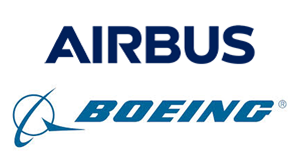Leeham News and Analysis
There's more to real news than a news release.
Pontifications: Airbus grows in China while Boeing remains on the sidelines
April 11, 2023, © Leeham News: Airbus last week firmed up an order for 150 A320neos and 10 A350-900s with China. The deal was announced last year.
Additionally, Airbus and the Chinese government agreed to add to the A320 family assembly site in Tianjin, increasing the capacity of the plant. This will be another step in Airbus’ goal to achieve a production rate of 75 per month by 2026 for the A320 family.
And that’s not all. Airbus and the China National Aviation Fuel Group (CNAF) signed a Memorandum of Understanding to increase the development of Sustainable Aviation Fuel.
Meanwhile, Boeing remains essentially frozen out of China. Deliveries of the 737 MAX remain stalled. Although China Southern Airlines outlined expected deliveries this year and through the next few years, we’ve seen this sort of thing before. Until an official announcement comes from Beijing authorizing deliveries, or some of the stored airplanes are delivered, words are just words.
That said, there are some solid indications we’re seeing that Boeing deliveries to China may well resume in the not-too-distant future, but on a glacial pace. The financial viability of some airlines within China, while opaque to outsiders, is monitored by the CAAC, China’s regulator. Some airlines are deemed too financially risky now to accept delivery of any new aircraft, whether the OEM is Boeing or Airbus.
While Boeing’s 140 MAXes originally ordered by China remained in a Twilight Zone of sorts, delivery of some Airbus A320neos also has been blocked. Generally, though, Airbus continues to tender airplanes and win orders while Boeing sits on the sidelines.
Bjorn’s Corner: New aircraft technologies. Part 7. Propulsion
April 7, 2023, ©. Leeham News: This is a summary of the article New aircraft technologies. Part 7P. Propulsion. The article discusses how developments in the next-generation airliner propulsion system will be the second most important area for improved efficiency and lower emissions after we have decided on the fuselage type.
Bjorn’s Corner: New aircraft technologies. Part 7P. Propulsion
Subscription required
By Bjorn Fehrm
April 7, 2023, ©. Leeham News: This is a complementary article to Part 7. Propulsion. It discusses in detail the next-generation propulsion systems and what to expect from their possible increase in performance and efficiency.
MCAS, The Aircraft Certification Act and the unintended consequences of Congressional Intervention
First in a Series of Articles
Subscription Required
By the Leeham News team
March 30, 2023, © Leeham News: Boeing is suffering delays getting the 737-7, 737-10, and 777X certifications completed.
Airbus delayed the certification of the A321XLR over the design of its integral fuel tank. Boeing has gotten the brunt of the blame for its delays, a stance not without some merit. Airbus is fully responsible for the design and integration of the XLR fuel tank. But, unlike Boeing, less has been said about the certification delays of the XLR than the Boeing aircraft.
These delays may not be completely the fault of the manufacturers.
A brief history. We know that two 737 MAXes were lost due to the Maneuvering Characteristics Augmentation System (MCAS) overpowering the flight crew’s ability to hand fly the airplane, although there were contributing factors. Congress got involved and demanded that the industry refocus on the safety of the flying public. The end result was the creation and passage of the Aircraft Certification, Safety and Accountability Act (ACSAA). This legislation mandated changes to how the Federal Aviation Administration oversees the manufacture of Transport Category Aircraft and set timelines for implementation.
We also need to remember that the industry is much larger than Boeing and Airbus. All manufacturers from those building agricultural aircraft and piston-powered helicopters and bizjets all the way through to Large Tier 1 subcontractors such as Spirit Aerospace and avionics manufacturers must respond to these changes. The Act affects everybody.
The addition of EICAS
We have seen references to the act and how it set a timeline for a monitoring program called Engine Indicating and Crew Alerting System, or EICAS, and its implementation. A deadline of last December was included in the ACSAA, adopted two years before. The inclusion of EICAS was adopted on the assumption Boeing would certify the MAX 7 and MAX 10 before the deadline. Exempting these two MAXes at the time was approved because the MAX 8 and MAX 9 were already certified without EICAS, and cockpit commonality was considered important among the four types.
But Boeing was unable to complete certification of the MAX 7 and MAX 10 in time. Steeped in controversy, Congress in January continued the exemption to September this year.
Certification by the deadline of the MAX 10, the last in the family, was always deemed a challenge because the -10 hadn’t entered flight testing at the time of the legislation’s approval. But the MAX 7 was well into its flight testing. People couldn’t understand why Boeing was unable to certify the MAX 7 before the end of last year.
An analysis by LNA lifts the veil on this mystery.
An uneven financial recovery among OEMs and Suppliers
Subscription Required
By Vincent Valery
Introduction
March 27, 2023, © Leeham News: In an article last year, LNA highlighted the divergence in the post-Covid-19 recovery among OEMs and select Tier 1 suppliers. Airbus had higher profits than before the Covid-19 pandemic, while all others lagged. Revenues were well below 2019 levels.
Commercial Aviation OEMs were severely impacted last year by supply chain disruptions. Airbus and Boeing ramped up production significantly slower than envisioned on all programs. The war in Ukraine and tighter financial conditions are complicating the situation further.
LNA collected financial information on the big three aircraft manufacturers and 10 major commercial aircraft suppliers to assess how quickly they recovered. There will also be an analysis of the numerous charges Airbus and Boeing have taken since 1999 through 2022.
Summary
- Significant differences among the three major aircraft OEMs;
- One engine OEM lagging;
- Some OEM suppliers are struggling financially;
- Twelve-digit accumulated charges at Airbus and Boeing combined.
A Chinese intervention in Ukraine would kill its aerospace industry
Subcription Required
By Bryan Corliss
Commentary
March 23, 2023, © Leeham News – Chinese leader Xi Jinping flew into Moscow this week for a three-day summit with accused Russian war criminal Vladimir Putin.
 They wined and dined. They talked publicly about economic accords and oil pipelines and pledged mutual support. In private, Putin almost certainly made a plea for stepped-up Chinese support for his faltering invasion of Ukraine. They made bold statements about banding together to oppose the hegemony of the West, which has united against Russia with sanctions including bans on providing Russia with the basic technology it needs to build weapons.
They wined and dined. They talked publicly about economic accords and oil pipelines and pledged mutual support. In private, Putin almost certainly made a plea for stepped-up Chinese support for his faltering invasion of Ukraine. They made bold statements about banding together to oppose the hegemony of the West, which has united against Russia with sanctions including bans on providing Russia with the basic technology it needs to build weapons.
 And at the end of it all, on Wednesday, Xi walked up the jet stairs to his Air China 747, built by Boeing in Everett, America. He turned and waved, and then flew back to Beijing.
And at the end of it all, on Wednesday, Xi walked up the jet stairs to his Air China 747, built by Boeing in Everett, America. He turned and waved, and then flew back to Beijing.
That moment, with Xi standing in front of the massive American-made jet, may just illustrate China’s conundrum right now: Xi, by all accounts, wants nothing more than to shove aside the post-Cold War order that has confined his nation from global Great Power status. An alliance with Putin’s Russia could be a key step toward that.
And Xi, as he looks around the interior of his jumbo jet, has to be acutely aware that China remains dependent upon the Western democracies for software, computer chips, and – critically – aircraft.
- War has created headaches for aerospace
- Chinese tensions are bigger issue
- China loses in a proxy war with West
- Boeing’s China business is effectively frozen
- Airbus in China may also be at risk
Pontifications: Complacency, arrogance aren’t a Boeing exclusive
March 21, 2023, © Leeham News: Airbus is resting on its laurels while Boeing struggles to recover from one crisis after another since the March 2019 grounding of the global 737 MAX fleet.
Multiple sources tell me that Airbus, aside from the production problems it has in common with Boeing, is enjoying Boeing’s deep freeze by China. The decision by Boeing CEO David Calhoun to delay the “introduction” of a new airplane until the middle of the next decade took the pressure off Airbus to be ready to move sooner than later.
While Boeing struggles, Airbus has become conservative, complacent and—gasp—even arrogant, a longtime Boeing trait.
What’s happening?
Regulatory filings spell out key 2023 challenges for Boeing, Airbus
Subscription required
By Bryan Corliss
March 20, 2023, © Leeham News – In a filing with federal regulators, The Boeing Co. acknowledges it struggled to stabilize 737 MAX production rates at 31 a month last year.
 However, the company is sticking to that and expects a “gradual” increase in 737 rates this year – dependent upon the ability of key suppliers to keep up.
However, the company is sticking to that and expects a “gradual” increase in 737 rates this year – dependent upon the ability of key suppliers to keep up.
Those are some of the takeaways from Boeing’s annual report, filed with the U.S. Securities and Exchange Commission earlier this year.
The reports, which are required under U.S. law for publicly traded companies, include much of the fine print that isn’t included in typical earnings releases and calls, including detailed discussions of the risks companies face.
The filing doesn’t contain any shocking revelations but does shed more light on how Boeing is coping with the challenges facing the industry: workforce recruitment and retention in a globally tight labor market, supply change management challenges, inflation, and geopolitical turmoil in key markets including China and Russia.
Reports also mirror information provided by Airbus in regulatory filings in the Netherlands, where the company is registered.
The filings paint a picture in which 2023 will be an important year for both OEMs as they try to recover from a series of serious setbacks.
Summary
- MAX rates could go up; Airbus backs off
- Supply chain a factor for both
- Boeing finding workers; Airbus raised pay
- Geopolitical tensions affect industry
Bjorn’s Corner: New aircraft technologies. Part 3P. Airframe improvements
Subscription required
By Bjorn Fehrm
March 10, 2023, ©. Leeham News: This is a complementary article to New aircraft technologies. Part 3. Airframe improvements. It discusses in detail the areas of an airliner airframe where tangible improvement can be made to make it more efficient and thus lower cost combined with less Green-House-Gas (GHG) emissions.
A deep dive into the twin-aisle market
Subscription Required
By Vincent Valery
Introduction
Feb. 20, 2023, © Leeham News: Last month, LNA analyzed the single-aisle market order opportunities for Airbus, Boeing, COMAC, Embraer, and UAC. We now focus on the twin-aisle duopoly of Airbus and Boeing.
Unlike in the single-aisle market, Boeing leads in market share: 64% nominally and 69% after Boeing’s at-risk ASC 606 adjustments and LNA’s assessment for Airbus, which doesn’t publish at-risk order numbers. If we exclude government and freighter orders, Boeing’s market share lead is 60% and 65% after at-risk adjustments.
However, the A330ceo family has the broadest operator base, and there are still almost 1,000 units in passenger service. LNA investigates the order twin-aisle aircraft order books and assesses replacement opportunities for both OEMs based on the in-service fleet.
Summary
- Boeing has the edge in the in-service fleet;
- Breaking down the order books between replacements and growth;
- Keep track of order choices for older-generation operators;
- Flip orders and airlines that did not order;
- The twin-aisle freighter market.





